2015 FIAT 500X roof
[x] Cancel search: roofPage 163 of 240
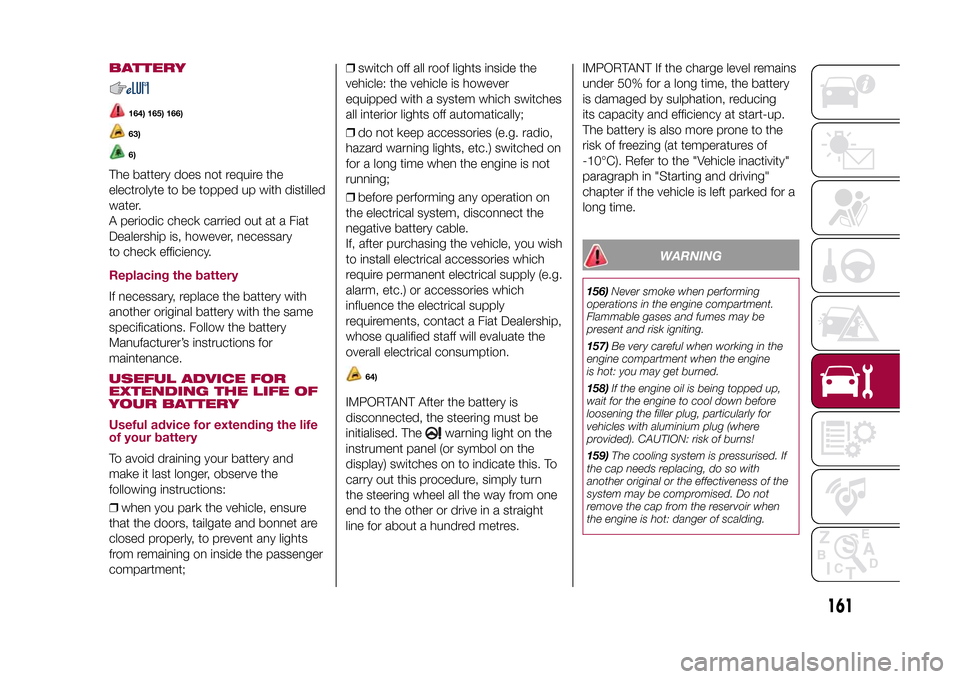
BATTERY
164) 165) 166)63)6)
The battery does not require the
electrolyte to be topped up with distilled
water.
A periodic check carried out at a Fiat
Dealership is, however, necessary
to check efficiency.Replacing the batteryIf necessary, replace the battery with
another original battery with the same
specifications. Follow the battery
Manufacturer’s instructions for
maintenance.USEFUL ADVICE FOR
EXTENDING THE LIFE OF
YOUR BATTERY
Useful advice for extending the life
of your batteryTo avoid draining your battery and
make it last longer, observe the
following instructions:
❒when you park the vehicle, ensure
that the doors, tailgate and bonnet are
closed properly, to prevent any lights
from remaining on inside the passenger
compartment;❒switch off all roof lights inside the
vehicle: the vehicle is however
equipped with a system which switches
all interior lights off automatically;
❒do not keep accessories (e.g. radio,
hazard warning lights, etc.) switched on
for a long time when the engine is not
running;
❒before performing any operation on
the electrical system, disconnect the
negative battery cable.
If, after purchasing the vehicle, you wish
to install electrical accessories which
require permanent electrical supply (e.g.
alarm, etc.) or accessories which
influence the electrical supply
requirements, contact a Fiat Dealership,
whose qualified staff will evaluate the
overall electrical consumption.
64)
IMPORTANT After the battery is
disconnected, the steering must be
initialised. The
warning light on the
instrument panel (or symbol on the
display) switches on to indicate this. To
carry out this procedure, simply turn
the steering wheel all the way from one
end to the other or drive in a straight
line for about a hundred metres.IMPORTANT If the charge level remains
under 50% for a long time, the battery
is damaged by sulphation, reducing
its capacity and efficiency at start-up.
The battery is also more prone to the
risk of freezing (at temperatures of
-10°C). Refer to the "Vehicle inactivity"
paragraph in "Starting and driving"
chapter if the vehicle is left parked for a
long time.
WARNING
156)Never smoke when performing
operations in the engine compartment.
Flammable gases and fumes may be
present and risk igniting.
157)Be very careful when working in the
engine compartment when the engine
is hot: you may get burned.
158)If the engine oil is being topped up,
wait for the engine to cool down before
loosening the filler plug, particularly for
vehicles with aluminium plug (where
provided). CAUTION: risk of burns!
159)The cooling system is pressurised. If
the cap needs replacing, do so with
another original or the effectiveness of the
system may be compromised. Do not
remove the cap from the reservoir when
the engine is hot: danger of scalding.
161
15-12-2014 8:23 Pagina 161
Page 167 of 240

WINDSCREEN/REAR
WINDOW WIPERReplacing the windscreen wiper
bladesProceed as follows:
❒raise the wiper arm, press button A
fig. 143 of the attachment spring and
remove the blade from the arm;
❒fit the new blade, inserting the tab in
the dedicated housing in the arm and
checking that it is locked;
❒lower the wiper arm on the
windscreen.
IMPORTANT Do not operate the
windscreen wiper with the blades lifted
from the windscreen.
Replacing the rear window wiper
bladeProceed as follows:
❒widen the two tabs as shown by the
arrows and rotate cover A fig. 144
outwards;
❒undo nut B and remove arm C from
the central pin;
❒correctly align the new arm;
❒fully tighten nut B and then refit cover
A.
IMPORTANT Do not operate the rear
window wiper with the blade lifted from
the rear window.Windscreen washerThe window washer nozzles are fixed. If
there is no jet of fluid, firstly check that
there is fluid in the reservoir (see
paragraph “Engine compartment” in
this chapter). Only use the prescribed
fluid; do not use only water.Then check that the nozzle holes are
not clogged; use a needle to unblock
them if necessary.
IMPORTANT In versions with sun roof,
make sure that the roof is closed before
operating the windscreen washer
nozzles.
Rear window washerThe rear window washer nozzle is fixed.
The jet nozzle is located at the side of
the third brake light.EXHAUST SYSTEM
168) 169)71)
Adequate maintenance of the engine
exhaust system represents the best
protection against leaks of carbon
monoxide into the passenger
compartment.AUTOMATIC
TRANSMISSION
72)
Use only a gearbox fluid with the same
characteristics as those indicated in
the "Fluids and lubricants" table (see
"Technical specifications" chapter).
143
F1B0302C
144
F1B0303C
165
15-12-2014 8:23 Pagina 165
Page 170 of 240
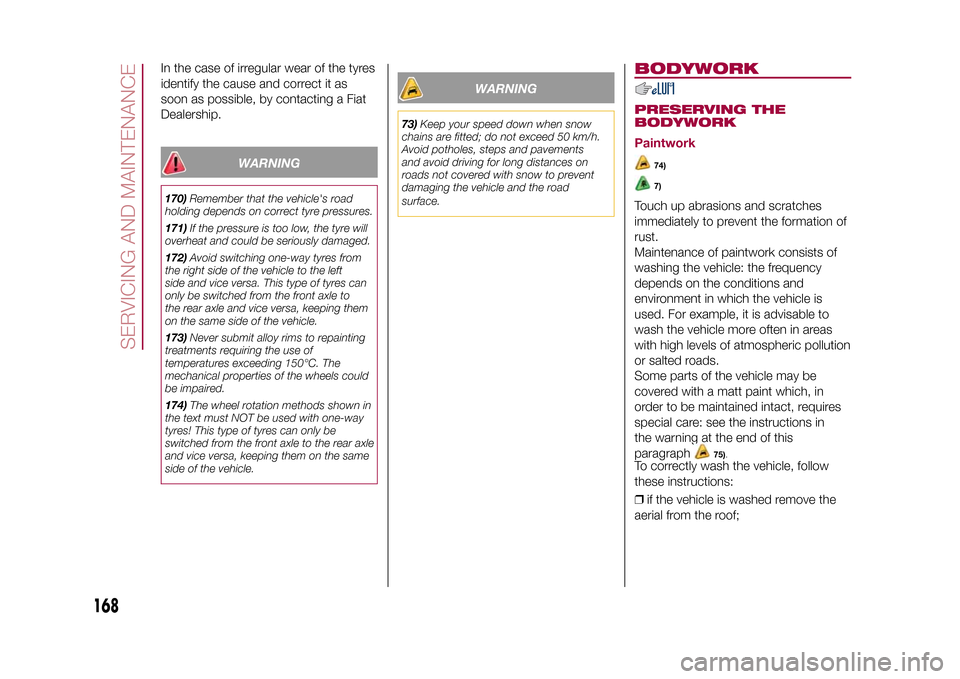
In the case of irregular wear of the tyres
identify the cause and correct it as
soon as possible, by contacting a Fiat
Dealership.
WARNING
170)Remember that the vehicle's road
holding depends on correct tyre pressures.
171)If the pressure is too low, the tyre will
overheat and could be seriously damaged.
172)Avoid switching one-way tyres from
the right side of the vehicle to the left
side and vice versa. This type of tyres can
only be switched from the front axle to
the rear axle and vice versa, keeping them
on the same side of the vehicle.
173)Never submit alloy rims to repainting
treatments requiring the use of
temperatures exceeding 150°C. The
mechanical properties of the wheels could
be impaired.
174)The wheel rotation methods shown in
the text must NOT be used with one-way
tyres! This type of tyres can only be
switched from the front axle to the rear axle
and vice versa, keeping them on the same
side of the vehicle.
WARNING
73)Keep your speed down when snow
chains are fitted; do not exceed 50 km/h.
Avoid potholes, steps and pavements
and avoid driving for long distances on
roads not covered with snow to prevent
damaging the vehicle and the road
surface.
BODYWORKPRESERVING THE
BODYWORK
Paintwork
74)7)
Touch up abrasions and scratches
immediately to prevent the formation of
rust.
Maintenance of paintwork consists of
washing the vehicle: the frequency
depends on the conditions and
environment in which the vehicle is
used. For example, it is advisable to
wash the vehicle more often in areas
with high levels of atmospheric pollution
or salted roads.
Some parts of the vehicle may be
covered with a matt paint which, in
order to be maintained intact, requires
special care: see the instructions in
the warning at the end of this
paragraph
75).
To correctly wash the vehicle, follow
these instructions:
❒if the vehicle is washed remove the
aerial from the roof;
168
SERVICING AND MAINTENANCE
15-12-2014 8:23 Pagina 168
Page 180 of 240

DIMENSIONSDimensions are expressed in mm and refer to the vehicle equipped with its standard-supplied tyres. Height is measured with
vehicle unladen. Small variations with respect to the reported values are possible depending on the dimensions of the rims.
AB C D E FGH I877 2570 801 4248
1600 / 1608
(*)
1545 1545 2025 1796
(*) With roof rack barsBoot volume: 350 litres. With rear seats folded: 1000 litres.149
F1B0169C
178
TECHNICAL SPECIFICATIONS
15-12-2014 8:23 Pagina 178
Page 182 of 240
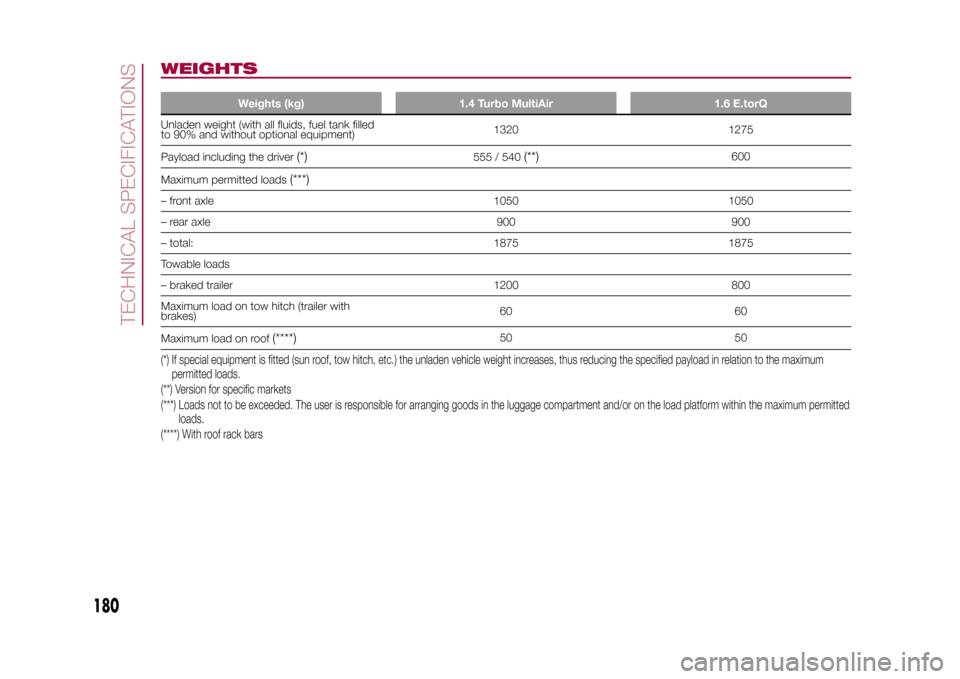
WEIGHTS
Weights (kg) 1.4 Turbo MultiAir 1.6 E.torQ
Unladen weight (with all fluids, fuel tank filled
to 90% and without optional equipment)1320 1275
Payload including the driver
(*)
555 / 540
(**)
600
Maximum permitted loads
(***)
– front axle 1050 1050
– rear axle 900 900
– total: 1875 1875
Towable loads
– braked trailer 1200 800
Maximum load on tow hitch (trailer with
brakes)60 60
Maximum load on roof
(****)
50 50
(*) If special equipment is fitted (sun roof, tow hitch, etc.) the unladen vehicle weight increases, thus reducing the specified payload in relation to the maximum
permitted loads.
(**) Version for specific markets
(***) Loads not to be exceeded. The user is responsible for arranging goods in the luggage compartment and/or on the load platform within the maximum permitted
loads.
(****) With roof rack bars
180
TECHNICAL SPECIFICATIONS
15-12-2014 8:23 Pagina 180
Page 183 of 240
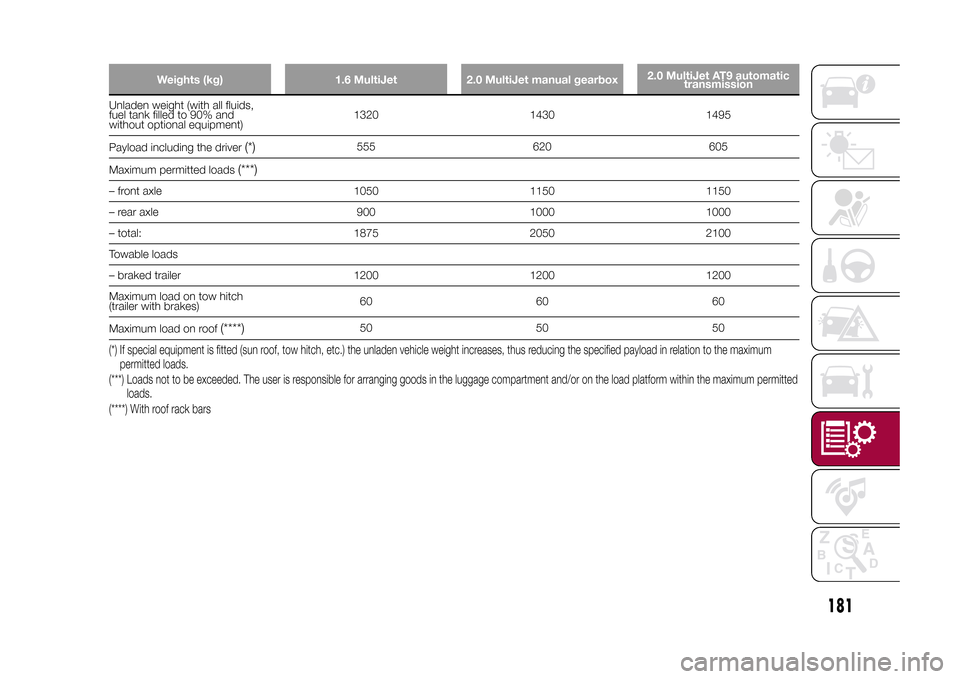
Weights (kg) 1.6 MultiJet 2.0 MultiJet manual gearbox2.0 MultiJet AT9 automatic
transmission
Unladen weight (with all fluids,
fuel tank filled to 90% and
without optional equipment)1320 1430 1495
Payload including the driver
(*)
555 620 605
Maximum permitted loads
(***)
– front axle 1050 1150 1150
– rear axle 900 1000 1000
– total: 1875 2050 2100
Towable loads
– braked trailer 1200 1200 1200
Maximum load on tow hitch
(trailer with brakes)60 60 60
Maximum load on roof
(****)
50 50 50
(*) If special equipment is fitted (sun roof, tow hitch, etc.) the unladen vehicle weight increases, thus reducing the specified payload in relation to the maximum
permitted loads.
(***) Loads not to be exceeded. The user is responsible for arranging goods in the luggage compartment and/or on the load platform within the maximum permitted
loads.
(****) With roof rack bars
181
15-12-2014 8:23 Pagina 181
Page 188 of 240

PERFORMANCETop speed reachable after the initial period of usage of the vehicle.
Versions km/h
1.4 Turbo MultiAir 140 HP190
1.4 Turbo MultiAir 136 HP
(*)
187
1.6 E.torQ180
1.6 MultiJet 120 HP186
1.6 MultiJet 115 HP
(*)
183
2.0 MultiJet 140 HP with manual gearbox - 4x4190
2.0 MultiJet 136 HP with manual gearbox - 4x4
(*)
187
2.0 MultiJet 140 HP AT9 automatic transmission - 4x4190
2.0 MultiJet 136 HP - AT9 automatic transmission - 4x4
(*)
187
(*) Version for specific marketsFUEL CONSUMPTIONThe fuel consumption values given in the table below are determined on the basis of the type-approval tests laid down by
specific European Directives. The procedures below are followed for measuring consumption:
❒urban cycle: cold starting followed by driving that simulates urban use of the vehicle;
❒extra-urban cycle: frequent accelerating in all gears, simulating extra-urban use of the vehicle: speed varies between 0 and
120 km/h;
❒combined fuel consumption: calculated with a weighting of approximately 37% of the urban cycle and 63% of the extra-
urban cycle.
IMPORTANT The type of route, traffic situations, weather conditions, driving style, general conditions of the car, trim level/
equipment/accessories, load, climate control system, roof rack, other situations that affect air drag may lead to different fuel
consumption levels than those measured. The fuel consumption will get more regular only after having driven the first 3000 km.
186
TECHNICAL SPECIFICATIONS
15-12-2014 8:23 Pagina 186
Page 231 of 240
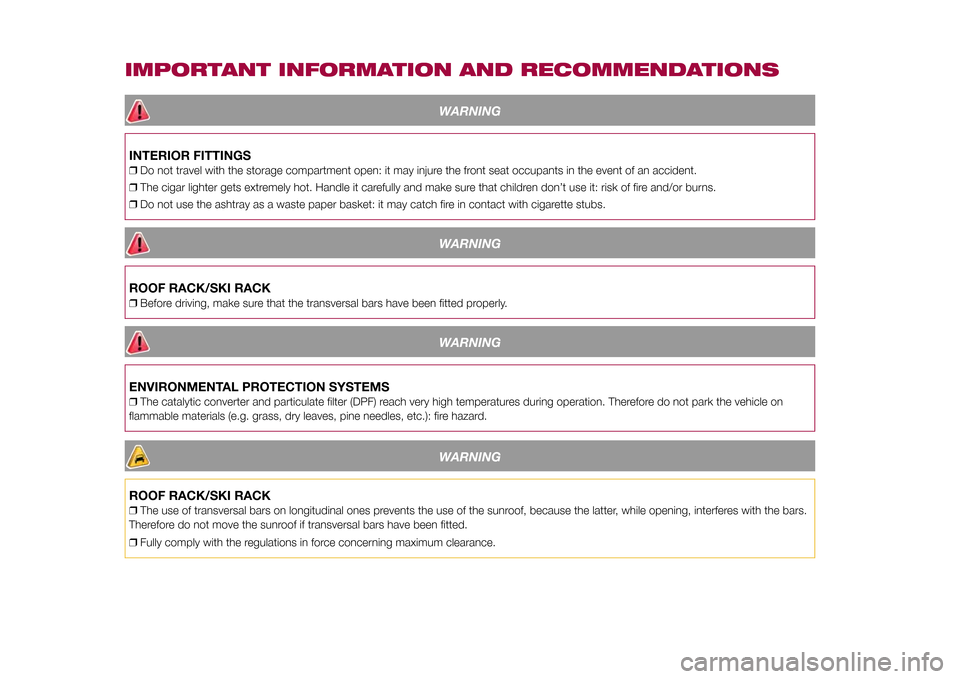
IMPORTANT INFORMATION AND RECOMMENDATIONS
WARNING
INTERIOR FITTINGS❒Do not travel with the storage compartment open: it may injure the front seat occupants in the event of an accident.
❒The cigar lighter gets extremely hot. Handle it carefully and make sure that children don’t use it: risk of fire and/or burns.
❒Do not use the ashtray as a waste paper basket: it may catch fire in contact with cigarette stubs.
WARNING
ROOF RACK/SKI RACK❒Before driving, make sure that the transversal bars have been fitted properly.
WARNING
ENVIRONMENTAL PROTECTION SYSTEMS❒The catalytic converter and particulate filter (DPF) reach very high temperatures during operation. Therefore do not park the vehicle on
flammable materials (e.g. grass, dry leaves, pine needles, etc.): fire hazard.
WARNING
ROOF RACK/SKI RACK❒The use of transversal bars on longitudinal ones prevents the use of the sunroof, because the latter, while opening, interferes with the bars.
Therefore do not move the sunroof if transversal bars have been fitted.
❒Fully comply with the regulations in force concerning maximum clearance.